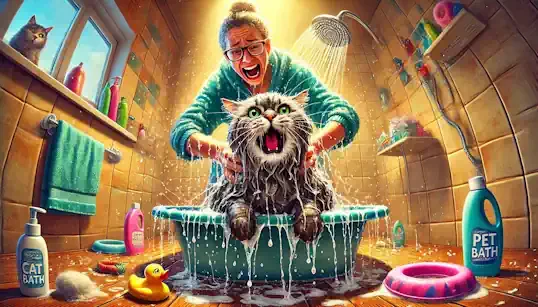The words "cat bath" often conjure images of chaos: flailing paws frantically seeking purchase, a symphony of hisses that could curdle milk, and a thoroughly soaked – and likely scratched – human emerging from the bathroom looking more like they wrestled a wild animal than attempted a simple hygiene routine. It's a scene many cat owners dread, a necessary evil perhaps, but certainly not an experience anyone would readily describe as “fun.” But what if we told you that bath time with your kitty could be different? What if, with a little preparation, a gentle approach, and a shift in mindset, you could transform bath time from a dreaded ordeal into a… well, maybe not a “party,” but certainly a far less stressful – dare we even whisper it – somewhat enjoyable experience for both you and your feline companion?
Let’s be realistic. Bathing a cat isn’t typically on anyone’s list of “fun weekend activities.” Cats are famously fastidious groomers, spending a significant portion of their day meticulously cleaning themselves. Their barbed tongues and naturally oily fur are remarkably efficient at keeping them relatively clean most of the time. However, there are definitely times when a bath becomes necessary, even for the most self-sufficient feline. Perhaps your adventurous kitty has decided to explore the muddiest corner of the garden, or maybe they've encountered something less-than-pleasant and are now sporting an aroma that rivals a week-old gym sock. In other cases, a bath might be medically indicated – perhaps your veterinarian has recommended medicated baths for skin conditions, or flea and tick shampoos to combat parasites. Hairless breeds, like Sphynx cats, also require more frequent bathing than their furrier counterparts to manage their skin oils. So, baths are sometimes unavoidable.
But here's the key to a better bath time: let's shift our mindset. Instead of aiming for "fun" in the human sense – bubble baths, rubber duckies, and splashing galore – let's aim for "less stressful." Let's focus on creating a calm and reassuring experience for your cat, one where they feel safe and secure, and where you can build positive associations with bath time, or at the very least, reduce the negative ones. This isn’t about forcing your cat to enjoy being submerged in water (that might be a bridge too far for most felines!), but it's about making the process manageable, efficient, and, dare we dream, maybe even a tiny bit bonding. This guide is dedicated to providing you with practical tips and techniques to do just that – to transform bath time from a chaotic battle into a more positive, or at least less dreadful, experience for both you and your cherished kitty. We’ll walk you through the essential preparation steps, provide a gentle and efficient step-by-step bathing guide, explore ways to make the experience a little more positive (dare we even use the “f” word – fun?), offer strategies for handling resistance, and guide you through the all-important post-bath pampering that will help end bath time on a happy note, for both of you!
The adage "preparation is key" holds exceptionally true when it comes to bathing cats. Rushing into a bath unprepared is almost guaranteed to result in chaos and stress for everyone involved. Taking the time to gather your supplies before you even think about approaching your cat with shampoo is absolutely crucial for efficiency and minimizing stress. First and foremost, you’ll need a good quality cat shampoo. Resist the temptation to reach for your own human shampoo – feline skin has a different pH balance than human skin, and human shampoos can be too harsh and drying for cats, potentially leading to skin irritation. Always choose a shampoo specifically formulated for cats. There are numerous options available, including gentle shampoos for sensitive skin, hypoallergenic formulas, and even flea shampoos if your veterinarian has recommended them for parasite control. Gather an arsenal of plush and absorbent towels. You’ll be surprised how many towels a seemingly small cat can soak through! Have several towels readily available, in different sizes if you find that helpful – larger towels for initial wrapping and drying, smaller towels for face and detail work.
To provide secure footing and prevent slipping in the sink or tub, use a non-slip bath mat or even just a towel placed on the bottom of the bathing area. This will help your cat feel more stable and less anxious during the bath. You’ll need a way to gently rinse your cat. A pitcher works well for controlled pouring, or a gentle showerhead or faucet with a hose attachment can also be effective, as long as you use a soft, diffused spray. Avoid forceful water pressure directly on your cat’s face. High-value, irresistible treats are your secret weapon for positive reinforcement. Have a stash of your cat’s absolute favorite treats readily accessible to reward calm behavior during the bath and offer as a positive association afterwards. A comb or brush is essential for both pre-bath and post-bath grooming. Pre-bath brushing helps remove loose fur and mats, making the bath more effective and reducing tangling later. Post-bath brushing helps fluff their fur as it dries and removes any remaining tangles. Cotton balls can be helpful for gently cleaning the outer ear flap after the bath if needed. Avoid inserting anything into the ear canal – cleaning should be limited to the visible outer ear. Rubber gloves can be optional but helpful for some owners. They can provide a better grip on a wet cat and protect your hands from accidental scratches. For particularly clever cats, or those prone to distraction, a lickable treat mat can be a game-changer. Smear a bit of cat-safe treat paste or wet food on a lickable mat and stick it to the wall of the sink or tub. This provides a tasty distraction and can keep them occupied while you’re bathing them.
Preparing the bathing area itself is just as important as gathering supplies. Choose your bathing location thoughtfully. A sink is often a good option for kittens or smaller cats, as it provides a contained space and is often at a comfortable height for owners. Bathtubs or basins are more suitable for larger cats. Consider what is easiest for you to manage and safest for your cat, based on their size and temperament. Fill your chosen basin with warm water – lukewarm is ideal. Test the water temperature on your wrist to ensure it is comfortably warm, not hot or cold. Ensure the room temperature is also comfortable and warm. Avoid chilly drafts in the bathroom, as you want to prevent your cat from getting chilled after their bath. Crucially, before you even bring your cat into the bathroom, close the door! This simple step is essential to contain the situation and prevent a wet, soapy, and potentially panicked cat from bolting through the house and turning your entire home into a slippery, sudsy escape route. Finally, try to minimize noise and distractions in the bathroom. Create a calm and quiet environment to help reduce your cat’s anxiety during the bath.
Just as you prepare the bathroom, pre-bath prep for your kitty is equally important. If your cat tolerates nail trims, trimming their nails before the bath is a wise precaution. Shorter, blunter nails will minimize the potential for accidental scratches to yourself during the bathing process. Give your cat a thorough brushing before bath time. Pre-bath brushing helps remove loose fur and any existing mats or tangles. This makes the bath itself more effective at cleaning their coat and reduces the likelihood of matting developing later as their fur dries. Consider tiring your cat out a little with a gentle play session before bath time. A short, engaging play session can help expend some of their excess energy and may make them slightly more relaxed and cooperative for the bath. Remember, a well-prepared bath time is a significantly smoother bath time for both you and your kitty!
With all your preparations in place, it’s time to actually bathe your cat. The key to a successful and less stressful bath is to be gentle, efficient, and reassuring throughout the process. Perhaps the most important element is to stay calm and confident yourself. Cats are incredibly sensitive to their owner's emotions. If you approach bath time with anxiety and apprehension, your cat will likely sense your unease and become more anxious themselves. Projecting calm and confidence will help reassure your cat that everything is okay, even if they’re not thrilled about being wet. Introduce your cat to the water gently and gradually. Avoid startling them with sudden splashes or forceful sprays. Begin by gently wetting their paws first, using a pitcher or a gentle showerhead/faucet with a soft spray. Slowly and gradually wet their fur, working your way upwards from their paws and legs, avoiding sudden immersion or forceful water flow, especially around their face. Use a pitcher or your gentle showerhead/faucet to pour or spray lukewarm water over their body, continuing to avoid spraying water directly into their face or ears. Throughout the wetting process, speak softly and reassuringly to your cat. Calm vocalization can help reassure them and make the experience feel less threatening.
Once your cat is thoroughly wet, it’s time to apply the shampoo. Some cat shampoos recommend dilution with water before application. Check the instructions on your specific shampoo and dilute it if recommended. Apply a small amount of shampoo to your hands and lather it gently, working from their neck downwards, avoiding their face, eyes, and ears. Focus on the dirtier areas of their coat, using a gentle massaging motion to work the shampoo into their fur. Strictly avoid getting shampoo in their eyes, ears, nose, and mouth, as these areas are sensitive and shampoo can cause irritation. Rinsing thoroughly is just as crucial as shampooing. Ensure all traces of shampoo are completely removed from their coat, as any shampoo residue can cause skin irritation and dryness. Rinse them thoroughly with lukewarm, clean water, continuing to use your gentle pouring or spraying technique. Rinse multiple times if necessary, making sure to reach all areas of their coat. Check that the water runoff is clear and free of suds, which is a good indication that all the shampoo has been rinsed away. Cleaning your cat’s face is usually best done with a damp cloth, rather than directly pouring water on their face. Use a soft, damp cloth or sponge, and gently wipe around their eyes and face, focusing on removing any dirt or debris. Again, be careful to avoid getting water directly in their eyes or ears. If needed, after the bath, you can gently clean the outer ear flap with a cotton ball moistened with water or a cat-specific ear cleaning solution (avoid inserting anything into the ear canal).
While a full-blown "fun" bath might be an unrealistic expectation for most cats, you can certainly make bath time a more positive and less stressful experience by incorporating positive reinforcement techniques. Positive reinforcement throughout the bath is key. Reward calm and cooperative behavior during the bath with small, high-value treats and verbal praise. If your cat tolerates gentle stroking during the bath, you can also incorporate gentle petting as a reward and reassurance. Maintain a gentle and reassuring tone of voice throughout the entire process. Talk calmly and softly to your kitty, offering verbal reassurance and praise. Your calm voice will help them feel more secure. Try to create a “spa” like atmosphere – calm, quiet, gentle handling, soft vocalizations. Think of it as a pampering session, not a forced ordeal. While distraction techniques can be helpful for some cats, use them judiciously. Lickable treat mats stuck to the wall of the sink or tub can distract some cats, keeping them occupied with a tasty treat while you bathe them. Floating toys in the water might distract some playful cats, but for others, unfamiliar objects in the water can be a source of anxiety. Use distraction techniques carefully and based on your cat’s individual personality and comfort level. The quicker the bath, the less stress for everyone involved. Efficiency is key. Have all your supplies prepped and ready to go, and work efficiently but gently through each step of the bathing process. Always end bath time on a positive note. Immediately after the bath is complete, shower your cat with high-value treats, gentle petting, and enthusiastic praise. This reinforces the positive association with bath time and helps them end the experience with positive feelings.
Despite your best efforts, some kitties are simply not going to embrace bath time with open paws. It’s important to recognize signs of extreme stress or fear in your cat. Hissing, growling, extreme struggling, panting, and frantic attempts to escape are all clear signals that your cat is becoming overly stressed and distressed. Learn to read these signals and know when to back off and avoid escalating the situation into a traumatic experience. If your cat is particularly resistant, enlisting a helper can make bath time significantly easier and safer for both of you. Having another person to help gently hold and reassure your cat can make the bathing process more manageable and reduce the risk of injury to either of you. For cats who are only mildly dirty or slightly smelly, consider “towel baths” or spot cleaning as gentler alternatives to a full immersion bath. Towel baths using damp cloths or pet wipes can be effective for removing surface dirt and odors. Spot cleaning can be used to address localized areas of dirt or mess. If your cat is highly stressed and truly panicking during a bath, shorten the bath and focus on the essentials. Prioritize cleaning only the dirtiest or smelliest areas, and end the bath as quickly as possible. Crucially, if your cat is completely panicking and becoming severely distressed, don’t force it. Forcing a bath when your cat is in a state of panic is counterproductive and can be damaging to your relationship and their overall well-being. It might be better to stop the bath attempt and try again another time, perhaps after using calming aids recommended by your veterinarian, or explore alternative cleaning methods like waterless shampoos or professional grooming. In situations involving severely matted fur, which can be painful and require specialized care, or if you are genuinely unsure how to safely bathe your cat, consult your veterinarian or a professional cat groomer. They have the expertise and experience to safely and effectively bathe cats, even those who are particularly challenging.
Once the bath is complete (and you’ve both survived!), it’s time for post-bath pampering – the happy ending for both you and your kitty! Immediately wrap your kitty in a warm, absorbent towel. Wrapping them quickly in a towel provides immediate comfort and begins the drying process. Gently towel dry them, rubbing gently and absorbing as much excess water as possible with the towel. A hair dryer can be used to speed up the drying process, but use it with caution. Use the hair dryer on a low heat and warm setting only, and always keep it at a safe distance from your cat to prevent overheating or burning their skin. Continuously monitor your cat for signs of stress while using a hair dryer, and stop immediately if they become agitated or fearful. For many cats, towel drying alone is less stressful than a hair dryer. After towel drying, brush your cat again. Post-bath brushing helps remove any remaining tangles, smooths their fur, and helps fluff it up as it dries, leaving them looking and feeling their best. Immediately shower your newly bathed kitty with lots of praise, affection, and high-value treats. This reinforces the positive association with bath time, rewarding their cooperation and helping them end the experience feeling loved and pampered. Engage in a fun play session with your cat after the bath. Playtime helps them release any pent-up energy from the bath in a positive and playful way, further shifting their focus away from any potential bath-related stress. Finally, carefully observe your cat post-bath to ensure they are warm, comfortable, and not showing any signs of chilling or lingering stress. Make sure they are thoroughly dry and are behaving normally after their bath.
Believe it or not, bath time, with the right approach, can even become a subtle bonding opportunity between you and your cat. Focus on gentle communication and understanding throughout the process. Use calm and reassuring body language and vocal cues. Pay close attention to your cat’s signals throughout the bath, and respect their boundaries. If they show signs of stress or discomfort, adjust your approach accordingly. Building trust is a gradual process, and consistent positive experiences, even with something potentially stressful like bathing, can contribute to building a stronger bond of trust over time. Even if bath time isn’t ever your cat’s favorite activity, by approaching it with patience, gentleness, and positive reinforcement, you can transform it from a dreaded chore into a manageable moment of care, and perhaps, just maybe, a slightly more positive experience that strengthens the special connection you share with your feline friend. Celebrate even small successes. Acknowledge and appreciate even small steps of progress. If your cat tolerates a bath for slightly longer than usual, or struggles a little less this time, recognize that as a win and reward their improved cooperation. Patience and consistent positive reinforcement will pay off over time, making bath time a less daunting task for both of you.
Cat baths may never be described as “fun” in the human sense of the word, but they certainly don’t have to be traumatic, chaotic battles either. By shifting your mindset, focusing on preparation, employing gentle techniques, incorporating positive reinforcement, and truly understanding and responding to your cat's cues, you can transform bath time from a dreaded chore into a more manageable – and even a little more positive – experience. Remember the key takeaways: prepare thoroughly, bathe gently, reinforce positively, understand your cat’s signals, and always end with pampering and affection. It takes time and practice to refine your bath time routine and make it easier for both of you. Don’t be discouraged if the first few attempts are challenging. Consistency, patience, and a gentle heart are your best allies. Embrace bath time not just as a necessary hygiene routine, but as an opportunity to care for your kitty’s health, strengthen your bond, and demonstrate your love and understanding for your feline companion. Ready to try a calmer bath time? Start with thorough preparation, gather your supplies, and approach your next bath with confidence and a gentle touch. You might be pleasantly surprised at just how much better it can be – for both you and your purrfectly clean kitty!







